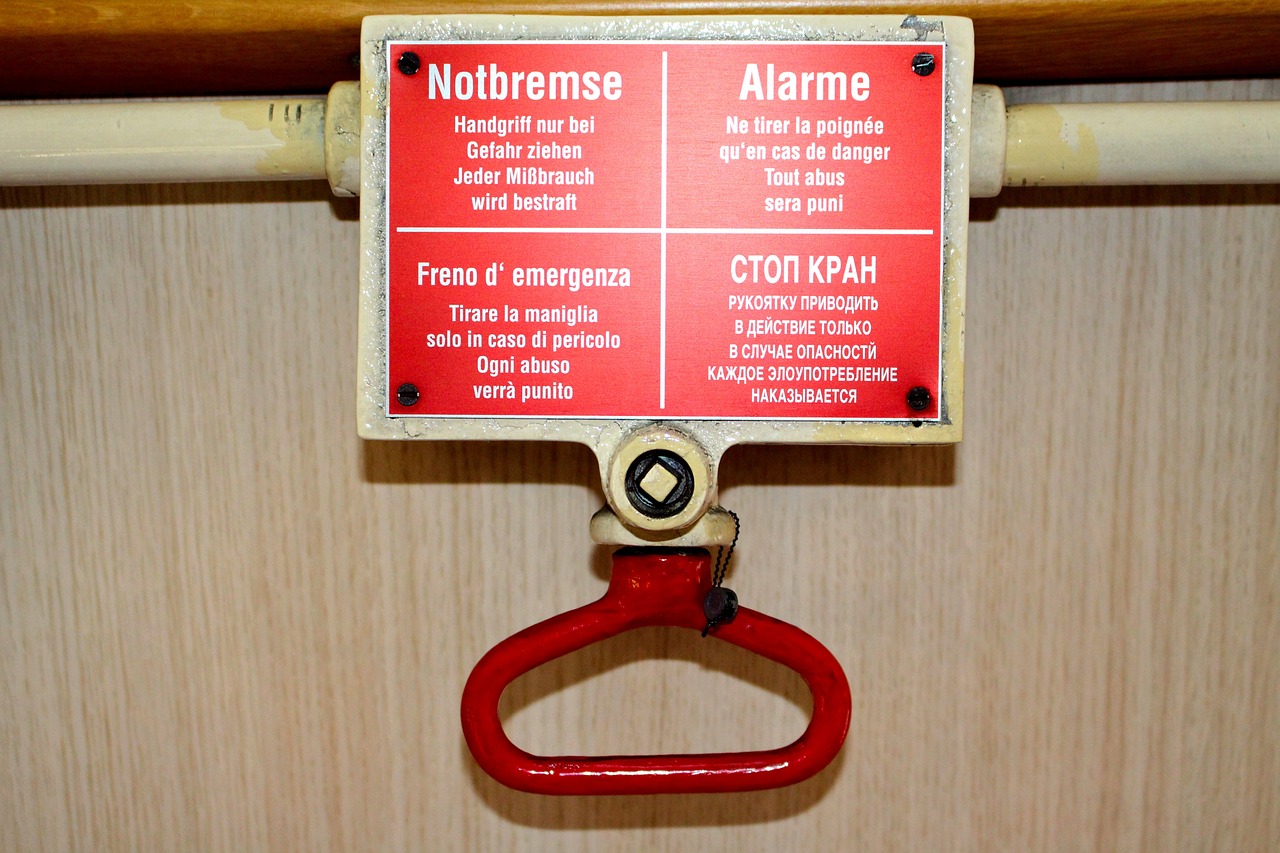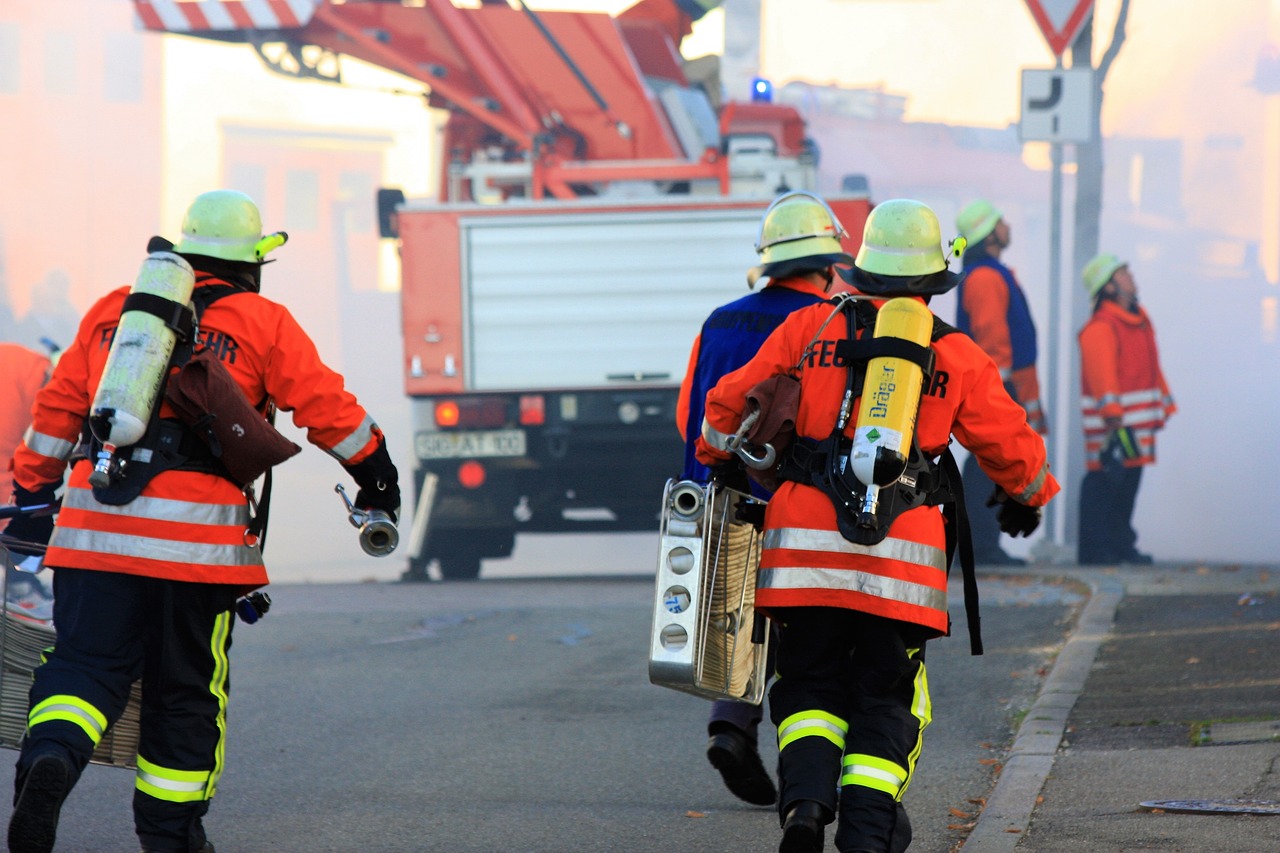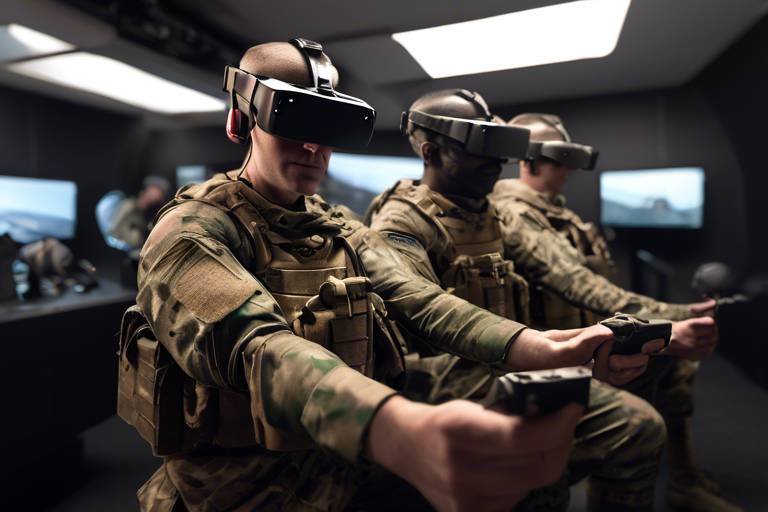Assessing the Applications of VR in Emergency Response Training
In an era where technology is rapidly reshaping how we learn and prepare for emergencies, virtual reality (VR) is emerging as a game-changer in the field of emergency response training. Imagine being able to step into a lifelike simulation of a natural disaster, a fire, or a medical emergency, all without leaving the safety of your training facility. This innovative approach not only enhances the realism of training exercises but also allows responders to practice their skills in a controlled environment. The immersive nature of VR creates a unique opportunity for trainees to engage with scenarios that they might encounter in real life, developing their decision-making abilities and honing their skills under pressure.
As we delve deeper into the world of VR, it's essential to recognize its transformative potential. Traditional training methods often rely on lectures, textbooks, or even outdated simulations that lack the necessary realism to prepare responders adequately. In contrast, VR can transport trainees into high-stakes situations, where they must think on their feet and react to dynamic challenges. This level of engagement not only makes training more enjoyable but also significantly boosts information retention. When learners are actively involved in their training, they are more likely to remember what they've learned and apply it effectively in real-world situations.
Moreover, the adaptability of VR technology means that training scenarios can be customized to reflect specific environments or incidents that responders might face in their respective regions. For instance, a fire department in a coastal area can simulate a rescue operation during a hurricane, while an urban emergency medical team can practice triage in a crowded subway station. This tailored approach ensures that each team can prepare for the unique challenges they may encounter, making their training more relevant and effective.
However, it's essential to acknowledge that the integration of VR into emergency response training is not without its challenges. Initial costs for VR equipment and software can be significant, and there may be a steep learning curve for trainers and trainees alike. Additionally, some may resist adopting new technologies, preferring traditional methods that they are more familiar with. Overcoming these hurdles will be crucial for organizations looking to harness the full potential of VR in their training programs.
As we look to the future, the possibilities for VR in emergency response training seem boundless. With advancements in technology, we can expect even more realistic simulations, enhanced interactivity, and broader adoption across various emergency services. The integration of artificial intelligence (AI) with VR could create adaptive training environments that respond to trainee actions, providing personalized feedback and improving learning outcomes. This synergy between AI and VR has the potential to revolutionize how we train emergency responders, making them more effective and prepared for real-life crises.
Furthermore, VR platforms can facilitate collaboration among emergency responders from different regions, promoting knowledge sharing and joint training exercises. Imagine a scenario where firefighters from different states can come together in a virtual space to practice a large-scale disaster response. This collaborative approach not only enhances individual skills but also fosters a sense of community and shared purpose among emergency responders.
In conclusion, the applications of VR in emergency response training are vast and varied. As we continue to explore this innovative technology, it becomes increasingly clear that VR is not just a trend; it is a vital tool that can significantly enhance preparedness and response capabilities in the face of emergencies. The future of emergency response training is here, and it is immersive, engaging, and incredibly promising.
- What is VR training? VR training utilizes virtual reality technology to create immersive training environments for emergency responders.
- How does VR improve training outcomes? By providing realistic simulations, VR enhances engagement and retention, allowing responders to practice decision-making in high-stress scenarios.
- What are the challenges of implementing VR training? Challenges include high initial costs, technical expertise requirements, and resistance from those accustomed to traditional training methods.
- Can VR training be customized? Yes, VR training scenarios can be tailored to specific environments and situations relevant to different emergency response teams.
- What is the future of VR in emergency response? The future looks promising, with advancements in technology leading to more realistic simulations and potential integration with AI for personalized training experiences.

The Role of VR in Emergency Training
This article explores the transformative impact of virtual reality (VR) on emergency response training, highlighting its benefits, challenges, and future potential in enhancing preparedness and response capabilities.
Virtual reality (VR) is revolutionizing the way emergency response training is conducted, offering an immersive experience that closely mimics real-life emergencies. Imagine being able to step into a virtual world where you can face a crisis head-on without any real-world consequences. This is what VR brings to the table. Trainees can practice critical decision-making and hone their skills in a safe environment, which significantly boosts their readiness for actual crisis situations. Instead of merely reading about emergency protocols or watching videos, they can engage in lifelike scenarios that challenge their abilities and instincts.
One of the most compelling aspects of VR training is its ability to create high-stress environments that are difficult to replicate in traditional training settings. For instance, a firefighter can experience a simulated fire scene, complete with smoke and heat, allowing them to practice their response in a controlled yet realistic manner. This kind of training not only enhances muscle memory but also prepares individuals for the psychological pressures they will face in real emergencies.
Moreover, VR technology allows for a variety of emergency situations to be simulated, from natural disasters to medical emergencies. This versatility means that training can be tailored to the specific needs of different teams. For example, a paramedic could engage in a scenario involving a mass casualty incident, while a police officer might practice handling a hostage situation. The ability to customize scenarios ensures that all trainees are well-prepared for the unique challenges they may encounter in their respective roles.
Additionally, VR training can be particularly useful for remote teams or those with limited access to traditional training facilities. It eliminates geographical barriers, allowing responders from different locations to participate in the same training exercises. This fosters a sense of community and collaboration among emergency personnel, enhancing overall preparedness.
In summary, the role of VR in emergency training is not just about technology; it's about transforming the learning experience. By providing a platform for immersive, realistic practice, VR helps trainees develop the skills, confidence, and readiness they need to respond effectively in real-life emergencies.
VR training provides numerous advantages, including enhanced engagement, improved retention of information, and the ability to simulate high-stress scenarios, leading to better performance in real-world emergencies.
Implementing VR training can be more cost-effective than traditional methods, reducing the need for physical materials, travel, and facility costs while providing scalable training options for various emergency response teams.
VR training can be designed to accommodate various learning styles and accessibility needs, ensuring that all team members, regardless of experience level, can benefit from the training.
Emergency response scenarios can be tailored to specific environments and situations, allowing teams to practice unique challenges they may face in their respective roles and locations.
Despite its benefits, integrating VR into emergency training poses challenges, including high initial costs, the need for technical expertise, and potential resistance from traditional training advocates.
The future of VR in emergency response training looks promising, with advancements in technology leading to more realistic simulations, enhanced interactivity, and broader adoption across various emergency services.
Combining VR with artificial intelligence can create adaptive training environments that respond to trainee actions, providing personalized feedback and improving learning outcomes in emergency response scenarios.
VR platforms can facilitate collaboration among emergency responders from different regions, promoting knowledge sharing and joint training exercises that enhance overall preparedness and response capabilities.
- What is VR training? VR training uses virtual reality technology to simulate real-life scenarios for training purposes.
- How does VR improve emergency response training? It provides immersive experiences that enhance decision-making, skill retention, and readiness for high-stress situations.
- Is VR training cost-effective? Yes, it can reduce costs associated with traditional training methods by minimizing the need for physical materials and travel.
- Can VR training be customized? Absolutely! Scenarios can be tailored to specific environments and challenges faced by different emergency response teams.
- What are the future trends for VR in emergency response? Future trends include greater integration with AI, more realistic simulations, and enhanced collaboration opportunities among responders.

Benefits of VR Training
When it comes to emergency response training, the benefits of virtual reality (VR) are nothing short of revolutionary. Imagine stepping into a lifelike simulation where every sound, sight, and sensation mirrors a real emergency scenario. This immersive experience not only enhances engagement but also significantly boosts the retention of information. Trainees can practice their skills repeatedly without the fear of real-world consequences, which is crucial when every second counts in a crisis.
One of the standout advantages of VR training is its ability to simulate high-stress scenarios. In traditional training, participants may face role-playing exercises that lack the intensity of a real emergency. However, VR can create a pressure-filled environment that mimics the chaos of a disaster, allowing responders to hone their decision-making skills under duress. This type of training is like a dress rehearsal for a play; it prepares the actors (or responders) to perform their best when the spotlight is on them.
Moreover, VR training is incredibly cost-effective. While the initial investment in VR technology may seem daunting, it often proves to be less expensive than traditional training methods over time. Consider the costs associated with physical materials, travel, and facility rentals for in-person training sessions. With VR, these expenses can be significantly reduced. Additionally, the scalability of VR training means that organizations can train multiple teams simultaneously, maximizing their resources efficiently.
Another remarkable benefit is the accessibility of VR training for diverse teams. It can be customized to accommodate various learning styles, ensuring that all team members, regardless of their experience level, can engage with the material effectively. For example, visual learners can benefit from the stunning graphics and scenarios, while auditory learners can absorb information through guided instructions. This tailored approach makes it possible for everyone to gain valuable skills, fostering a more competent and confident team.
Furthermore, the customizability of VR scenarios is a game-changer. Trainers can design specific emergency situations that teams might encounter in their unique environments. Whether it's a natural disaster, a hazardous materials incident, or an active shooter scenario, VR can be tailored to reflect the challenges responders are likely to face. This level of specificity not only prepares teams for their specific roles but also enhances their overall effectiveness in real-world situations.
In summary, the benefits of VR training in emergency response are multifaceted. From enhanced engagement and retention to cost savings and accessibility, VR is paving the way for a new era of preparedness. As organizations continue to recognize these advantages, the adoption of VR training is set to grow, ultimately leading to more effective and efficient emergency response teams.
- What is VR training? - VR training involves using virtual reality technology to create immersive training experiences that replicate real-life situations.
- How does VR training improve retention? - The immersive nature of VR enhances engagement, making it easier for trainees to remember procedures and skills.
- Is VR training cost-effective? - Yes, while the initial setup may be costly, VR training can reduce long-term expenses associated with traditional training methods.
- Can VR training accommodate different learning styles? - Absolutely! VR can be customized to cater to various learning preferences, ensuring that all team members benefit.
- What types of scenarios can be simulated with VR? - VR can simulate a wide range of emergency situations, from natural disasters to medical emergencies, tailored to specific needs.

Cost-Effectiveness of VR Solutions
When it comes to emergency response training, the cost-effectiveness of virtual reality (VR) solutions is a game changer. Traditional training methods often require substantial investments in physical materials, travel expenses, and the use of specialized facilities. In contrast, VR training offers a more efficient alternative that can significantly reduce these costs. Imagine being able to conduct realistic training sessions without the need for costly props or extensive logistics. This is where VR shines, allowing organizations to allocate their budgets more effectively.
One of the most compelling aspects of VR training is its scalability. Organizations can train multiple personnel simultaneously in a virtual environment, eliminating the need for multiple training sessions for different teams. This not only saves time but also maximizes the use of resources. For instance, a single VR simulation can be accessed by dozens of trainees at once, providing them with the opportunity to engage in hands-on learning without the constraints of physical space.
Additionally, VR training can be customized to reflect specific scenarios that responders might face in their roles. This means that organizations can create tailored experiences that address unique challenges, ensuring that every dollar spent on training is utilized to its fullest potential. The ability to replicate various emergency situations, from natural disasters to medical emergencies, makes VR an invaluable tool for enhancing preparedness.
Furthermore, let's break down some of the key financial advantages of VR training:
| Cost Factor | Traditional Training | VR Training |
|---|---|---|
| Material Costs | High | Low |
| Travel Expenses | Significant | Minimal |
| Facility Rental | Required | Not Required |
| Scalability | Limited | High |
As you can see, the financial implications of adopting VR training are clear. Organizations not only save money but also enhance the overall quality of training. By investing in VR solutions, emergency response teams are not just preparing for the worst; they are doing so in a way that is financially savvy and sustainable.
In conclusion, the cost-effectiveness of VR training solutions is a significant factor driving their adoption in emergency response scenarios. By reducing costs associated with traditional training methods and providing scalable, customizable experiences, VR is revolutionizing the way teams prepare for emergencies. With these advantages in mind, it's no wonder that more organizations are turning to this innovative technology.
- What are the initial costs associated with implementing VR training?
The initial costs can vary based on the technology and software chosen, but many organizations find that the long-term savings outweigh these upfront investments.
- Can VR training be used for all types of emergency response?
Yes, VR training can be tailored to fit various emergency scenarios, including medical emergencies, natural disasters, and fire safety.
- How does VR training compare to traditional methods in terms of effectiveness?
Many studies suggest that VR training can enhance retention and engagement, leading to better performance in real-world situations compared to traditional methods.
- Is VR training accessible for all team members?
Yes, VR training can be designed to accommodate diverse learning styles and accessibility needs, ensuring inclusivity for all team members.

Accessibility for Diverse Teams
One of the most remarkable aspects of virtual reality (VR) training is its ability to cater to a wide range of learning styles and accessibility needs. Imagine a training environment where every individual, regardless of their background or experience, can engage fully and effectively. This is not just a dream—it's a reality made possible by VR technology. By creating immersive experiences that are adaptable, VR ensures that all team members can participate in emergency response training, which is crucial for building a cohesive and capable response team.
For instance, VR can incorporate various sensory inputs, such as visual and auditory cues, which can be tailored to accommodate different learning preferences. Some individuals may grasp concepts better through visual simulations, while others might benefit from auditory instructions. This flexibility allows trainers to design scenarios that are not only engaging but also effective in reinforcing critical skills.
Moreover, VR platforms can be equipped with features that assist individuals with disabilities. For example, those with mobility challenges can experience emergency situations without the physical constraints they might face in real life. This inclusivity not only boosts confidence among team members but also enhances the overall effectiveness of the training program. Here are some key points regarding accessibility in VR training:
- Customizable Interfaces: VR training programs can be adjusted to meet the specific needs of each user, ensuring that everyone can navigate and participate comfortably.
- Realistic Scenarios: By simulating a variety of emergency situations, teams can practice responding to unique challenges, making the training relevant to their specific roles.
- Feedback Mechanisms: VR can provide real-time feedback, allowing trainees to improve their skills continuously and adapt their approaches based on performance.
As we look to the future, it’s clear that the ability to make VR training accessible to diverse teams will not only enhance individual preparedness but also strengthen the collective response capability of emergency services. The more inclusive the training environment, the better equipped the team will be to handle real-world emergencies. After all, in crisis situations, every second counts, and having a well-prepared team can make all the difference.
Q1: How does VR training accommodate different learning styles?
A1: VR training can incorporate various sensory inputs and customizable interfaces, allowing users to engage with the material in a way that suits their individual learning preferences.
Q2: What types of disabilities can be accommodated in VR training?
A2: VR training can be designed to assist individuals with mobility challenges, visual impairments, and other disabilities by providing tailor-made experiences that ensure full participation.
Q3: Is VR training more effective than traditional methods?
A3: Many studies suggest that VR training enhances engagement, retention, and decision-making skills, making it a powerful tool compared to traditional training methods.

Customizable Scenarios
One of the most exciting aspects of virtual reality (VR) training in emergency response is the ability to create tailored to specific environments and situations. Imagine a firefighter training in a simulated high-rise building fire or an EMT practicing triage in a crowded concert venue. These scenarios aren't just random; they are designed to mimic the unique challenges that responders may face in their respective roles and locations. This level of customization ensures that trainees are not only practicing skills but are also immersed in realistic conditions that they might encounter in real life.
By utilizing advanced VR technology, training programs can adjust various parameters of the scenarios, such as:
- Environment: Different locations like urban, rural, or industrial settings can be simulated.
- Incident Type: Scenarios can range from natural disasters to man-made emergencies, each with its own set of challenges.
- Variable Factors: Elements such as weather conditions, time of day, and the presence of bystanders can be manipulated to enhance realism.
Furthermore, this flexibility allows for the incorporation of real-time feedback based on trainee performance. For example, if a trainee misses a critical step in a rescue operation, the VR system can adapt the scenario to present an additional challenge or consequence, reinforcing the importance of that step. This immediate feedback loop not only aids in skill retention but also fosters a deeper understanding of the complexities involved in emergency response.
Moreover, customizable scenarios can be used to address specific training needs within different emergency response teams. For instance, a law enforcement agency might focus on scenarios involving active shooter situations, while a medical team may prioritize mass casualty incidents. This targeted approach ensures that every team member is well-prepared for the specific challenges they are likely to face in their line of duty, ultimately enhancing their overall readiness and confidence.
As VR technology continues to advance, the potential for even more intricate and diverse scenarios expands. Future developments may include the integration of augmented reality (AR) elements, allowing for hybrid training experiences where real-world environments are enhanced with virtual components. This could lead to unprecedented levels of realism and interactivity in training programs, making them not only effective but also engaging for participants.
Q1: How realistic are the scenarios in VR emergency training?
A1: The realism of VR scenarios can be incredibly high, utilizing advanced graphics and sound design to create immersive environments that closely mimic real-life situations.
Q2: Can VR training be adapted for different emergency services?
A2: Absolutely! VR training can be customized for various emergency services, including fire, medical, and law enforcement, allowing each team to focus on their specific challenges.
Q3: What kind of feedback do trainees receive during VR training?
A3: Trainees receive real-time feedback based on their actions within the scenario, helping them understand what they did well and where they can improve.
Q4: Is VR training cost-effective compared to traditional methods?
A4: Yes, while the initial investment in VR technology can be high, the long-term savings from reduced material costs, travel, and the ability to train more personnel efficiently make it a cost-effective solution.

Challenges in Implementing VR Training
While the potential of Virtual Reality (VR) in emergency response training is undeniably exciting, the journey toward widespread adoption is not without its hurdles. One of the most significant challenges is the initial investment. Setting up a VR training program often requires substantial upfront costs for hardware and software, which can be a daunting barrier for many organizations. Think about it: you’re not just buying a headset; you’re investing in a whole new way of training that might take time to pay off.
Another concern is the technical expertise needed to implement and maintain VR systems. Many emergency response teams may not have the necessary IT support or technical know-how to effectively integrate VR into their training protocols. This can lead to frustration and inefficiencies, as teams struggle to troubleshoot issues or adapt the technology for their specific needs. Imagine trying to navigate a complex system without a map; it can be overwhelming and counterproductive.
Moreover, there can be resistance from traditionalists within the training community. Some instructors and responders may be skeptical about the effectiveness of VR compared to conventional training methods. They might argue that nothing can replicate the real-life experience of handling emergencies. This mindset can create a divide, making it challenging to introduce innovative training methods. It’s akin to trying to convince someone that a smartphone is better than a flip phone; change can be hard for many to accept.
Additionally, there are concerns regarding the physical and psychological impacts of using VR. Some users may experience motion sickness or disorientation while using VR headsets, which can detract from the training experience. Furthermore, immersing trainees in high-stress scenarios could lead to anxiety or trauma, especially for those who have previously encountered real emergencies. It’s crucial to ensure that VR training is designed thoughtfully to mitigate these risks.
In summary, while the challenges of implementing VR training in emergency response are significant, they are not insurmountable. By addressing the initial costs, providing technical training, and fostering an open mindset toward new methods, organizations can unlock the transformative potential of VR. The key lies in balancing innovation with practicality, ensuring that all responders are equipped and ready to face real-world challenges.
- What is the cost of implementing VR training? - The initial investment can vary widely depending on the technology chosen, ranging from a few thousand to tens of thousands of dollars.
- Can VR training replace traditional methods? - While VR offers unique benefits, it is best used as a complementary tool alongside traditional training methods.
- What types of emergencies can be simulated using VR? - VR can simulate a wide range of scenarios, including natural disasters, medical emergencies, and hazardous material incidents.
- Are there any health risks associated with VR training? - Some users may experience motion sickness or anxiety; thus, proper design and user training are essential.

Future Trends in VR for Emergency Response
As we look ahead, the future of virtual reality (VR) in emergency response training is shaping up to be not only exciting but also transformative. With ongoing advancements in technology, VR is set to become even more integral in preparing responders for high-pressure situations. Imagine a world where emergency personnel can train in hyper-realistic simulations that mirror the complexities of real-life crises. This is not far off, and several key trends are emerging that will redefine how we approach emergency training.
One of the most promising trends is the integration of VR with artificial intelligence (AI). By combining these two powerful technologies, we can create adaptive training environments that respond dynamically to the actions of trainees. For example, an AI-driven VR scenario could adjust the difficulty level based on a trainee’s performance, providing personalized feedback and making the learning experience more effective. This level of interactivity ensures that each training session is unique and tailored to the individual’s needs, ultimately leading to improved outcomes in real emergencies.
Moreover, the rise of collaboration and networking opportunities within VR platforms is another trend to watch. These platforms can facilitate joint training exercises among emergency responders from different regions, allowing teams to share knowledge and best practices. Imagine firefighters from one city collaborating with paramedics from another, all within a VR environment. This kind of cross-training not only enhances the skills of individual teams but also fosters a sense of unity and shared purpose among various emergency services. The ability to train together in a virtual space can lead to better coordination and communication during actual emergencies, which is crucial for effective response.
Another exciting development is the increased realism of simulations. As technology continues to advance, VR simulations are becoming more detailed and lifelike. This includes everything from realistic soundscapes to accurate representations of environments and scenarios. Trainees will find themselves immersed in situations that closely resemble real-life emergencies, allowing them to practice their skills in a safe yet challenging environment. This heightened realism will not only improve engagement but also enhance the retention of critical information, making it easier for responders to recall their training when it matters most.
Additionally, the accessibility of VR training is expected to improve significantly. As the technology becomes more mainstream, costs are likely to decrease, allowing a wider range of emergency response teams to implement VR training. This democratization of training resources means that even smaller or underfunded departments can take advantage of cutting-edge training tools. Furthermore, VR can be designed to accommodate various learning styles, ensuring that all team members, regardless of their background or experience level, can participate and benefit from the training.
In summary, the future of VR in emergency response training is bright, with trends such as AI integration, collaborative platforms, increased realism, and improved accessibility paving the way for more effective and engaging training experiences. As these technologies continue to evolve, they will undoubtedly enhance preparedness and response capabilities, ultimately saving lives in critical situations.
- What is VR training? VR training uses virtual reality technology to create immersive training environments that simulate real-life scenarios.
- How does VR improve emergency response training? It enhances engagement, retention, and decision-making skills by allowing trainees to practice in safe, realistic settings.
- Are there any challenges to implementing VR training? Yes, challenges include initial costs, the need for technical expertise, and potential resistance from traditional training advocates.
- What future trends can we expect in VR for emergency response? Key trends include AI integration, enhanced realism, collaboration opportunities, and improved accessibility.

Integration with AI Technologies
Imagine stepping into a virtual world where every decision you make is met with immediate feedback, almost as if you were in a real-life emergency scenario. This is the magic that happens when virtual reality (VR) meets artificial intelligence (AI). The integration of these two groundbreaking technologies is revolutionizing emergency response training, creating a dynamic learning environment that adapts to the actions of the trainee. As a result, participants can experience a more personalized training session that not only enhances their skills but also boosts their confidence when facing real emergencies.
One of the most exciting aspects of this integration is the ability to create adaptive training environments. For instance, AI algorithms can analyze a trainee's performance in real-time and adjust the difficulty level of the scenarios accordingly. If a trainee is excelling at managing a fire emergency but struggles with medical response, the system can present more challenging medical scenarios to help them improve. This tailored approach ensures that each individual receives the training they need, making the learning experience much more effective.
Moreover, the combination of VR and AI can facilitate realistic simulations that mimic the unpredictability of actual emergencies. For example, AI can introduce unexpected variables into a VR scenario, such as sudden equipment failures or the presence of multiple casualties, requiring trainees to think on their feet and adapt their strategies. This unpredictability is crucial in preparing emergency responders for the chaos they may encounter in real-life situations.
In addition to enhancing the training experience, the integration of AI technologies can also streamline the assessment process. AI can track and evaluate a trainee's performance over time, providing detailed analytics that can highlight strengths and areas for improvement. This data-driven approach not only helps trainers refine their programs but also empowers trainees to take ownership of their learning journey.
Furthermore, the collaborative potential of AI and VR cannot be overstated. By leveraging cloud-based platforms, emergency responders from different geographical locations can engage in joint training exercises, sharing insights and strategies in real-time. This collaboration fosters a sense of community among responders, ultimately leading to better preparedness and response capabilities across the board.
In summary, the integration of AI technologies into VR training for emergency response is a game-changer. It creates a more engaging, personalized, and effective training environment that prepares responders for the unpredictable nature of their work. As we continue to see advancements in both VR and AI, the future of emergency response training looks not only promising but also incredibly exciting.
- What is the main benefit of integrating AI with VR in emergency response training?
Integrating AI with VR allows for adaptive training environments that respond to the trainee's actions, providing personalized feedback and enhancing the overall learning experience. - Can VR training replace traditional emergency response training methods?
While VR training offers many advantages, it is best used as a complementary tool alongside traditional methods to create a comprehensive training program. - How does AI enhance the realism of VR training scenarios?
AI can introduce unexpected variables and challenges into VR scenarios, closely mimicking the unpredictable nature of real-life emergencies. - Is VR training accessible for all emergency response teams?
Yes, VR training can be customized to accommodate various learning styles and accessibility needs, making it beneficial for diverse teams.

Collaboration and Networking Opportunities
Virtual reality (VR) is not just a tool for individual training; it opens up a world of among emergency responders. Imagine a scenario where firefighters from different regions can come together in a virtual environment to tackle a simulated wildfire. This kind of immersive experience fosters teamwork and enhances communication skills, which are vital during real emergencies.
Through VR platforms, responders can engage in joint training exercises that mimic real-world challenges, allowing them to work together in a controlled setting. This collaboration helps build trust and camaraderie among team members, which can be crucial when lives are on the line. Furthermore, VR allows for the inclusion of diverse teams, breaking down geographical barriers and enabling responders from various backgrounds to learn from each other.
Consider the power of shared experiences in enhancing preparedness. When different emergency services—such as police, fire, and medical teams—train together in VR, they can better understand each other's roles and establish protocols for effective communication during crises. This holistic approach to training not only improves individual skills but also strengthens the overall response framework.
Moreover, VR technology can facilitate knowledge sharing through virtual workshops and seminars. Experts from various fields can host interactive sessions, providing insights and best practices that can be applied in real-world situations. This continuous learning environment cultivates a culture of innovation and adaptability, essential traits for emergency responders.
Another exciting aspect of VR collaboration is the potential for networking. Responders can connect with peers globally, exchanging ideas and strategies that may not be prevalent in their local training programs. This exchange of information can lead to the development of new techniques and methodologies, further enhancing the effectiveness of emergency response efforts.
In summary, the integration of VR in emergency response training not only enhances individual preparedness but also promotes collaboration and networking opportunities that are essential for effective crisis management. As we look to the future, embracing these technologies will undoubtedly pave the way for more coordinated and efficient emergency response teams.
- What is virtual reality training?
Virtual reality training uses immersive technology to simulate real-life scenarios, allowing users to practice skills in a controlled environment. - How does VR improve emergency response training?
VR enhances engagement, retention, and decision-making skills by providing realistic simulations of emergency situations. - Are there any challenges in implementing VR training?
Yes, challenges include high initial costs, technical expertise requirements, and potential resistance from traditional training advocates. - Can VR training be customized?
Absolutely! VR scenarios can be tailored to fit specific environments and unique challenges faced by different emergency response teams. - What is the future of VR in emergency response?
The future looks promising, with advancements in technology leading to more realistic simulations and broader adoption across various emergency services.
Frequently Asked Questions
- What is virtual reality (VR) training for emergency response?
Virtual reality training for emergency response is an immersive learning experience that simulates real-life emergency situations. It allows trainees to practice their skills and decision-making in a controlled, safe environment, enhancing their preparedness for actual crises.
- How does VR improve engagement in training?
VR enhances engagement by providing interactive and immersive scenarios that capture the trainees' attention. Instead of passive learning, participants actively engage with the environment, making the training experience more memorable and effective.
- Is VR training cost-effective compared to traditional methods?
Yes, VR training can be more cost-effective in the long run. It reduces expenses associated with physical materials, travel, and facility rentals. Moreover, it offers scalable solutions that can be adapted for various emergency response teams without significant additional costs.
- Can VR training accommodate different learning styles?
Absolutely! VR training can be tailored to meet diverse learning styles and accessibility needs. This ensures that all team members, regardless of their experience level or preferred learning methods, can effectively benefit from the training.
- What challenges are associated with implementing VR training?
While VR training offers many benefits, challenges include high initial costs, the need for technical expertise, and potential resistance from those accustomed to traditional training methods. Addressing these challenges is crucial for successful integration.
- What future trends can we expect in VR for emergency response training?
The future of VR in emergency response training looks bright, with advancements leading to more realistic simulations and enhanced interactivity. We can also expect broader adoption across various emergency services as technology continues to evolve.
- How can VR be integrated with AI technologies?
Combining VR with artificial intelligence can create adaptive training environments that respond to trainee actions. This integration allows for personalized feedback, improving learning outcomes and making training more effective.
- Can VR platforms facilitate collaboration among responders?
Yes! VR platforms can promote collaboration among emergency responders from different regions. This fosters knowledge sharing and joint training exercises, ultimately enhancing overall preparedness and response capabilities.



















